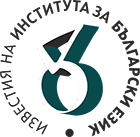Analysis of the Morphological Category ‘Indefiniteness/Definiteness’ in the Bulgarian Language System in Terms of Emergence, Development, Sustainability and Specificity of the Morphological Indicator for Determination
Iliyana G. Garavalova
Institute for Bulgarian Language, Bulgarian Academy of Sciences
Abstract
The study reviews the reasons why a well established morphological category of ‘indefiniteness / definiteness’ emerged, developеd and remained intact in the Bulgarian language unlike all other Slavic languages that brings it closer from typological point of view to Balkan and West European languages. As a main factor for the appearance of the observed grammatical pattern the affiliation of Bulgarian to the Indo-European language family is pointed out. Its iconicity in relation to the morphological dominant of the inflectional morphological type of languages generates the main tendency in the development of those languages – the one of reducing the average amount of grammatical information which the grammatical morphemes are able to communicate aiming at preserving the basic features of the inflectional type. As a result of the combined action of its two basic manifestations – the tendency of analytism and the appearance of some agglutinative characteristics within the inflectional language system – in Bulgarian comes to life the morphological category
‘indefinitеness / definitеness’. The combined action determines the development of the category in question from the Old Bulgarian period till present day. From synchronic point of view, two types of patterns in the observed paradigm of nouns are preserved in terms
of the usage of articles – with one and with three articles. The second one also has two subtypes that depend on the origin and composition of their formal definitеness markers. In the paper the causes of the present status quo are presented from the point of view of
the theory of grammatical oppositions that step by step lead to a relative restriction in the area of spreading of the system with three articles, and fostered the spread of the system aiming at gradual reduction to one article. As a result, most of the dialects in the Bulgarian
language territory use one article and that pattern was accepted as the standard one in the modern Bulgarian literary language. The present paper also deals with the problem of the morphological nature of the definite article in Bulgarian. As justified by a detailed analysis of the way the formal marker for notation of definiteness functions within the nominal phrase and by its specifics as a bimorphemic marker, the conclusion logically follows that its morphological nature amounts to a semi-agglutinative formant. As a proof for this claim a set of indicative examples are provided from both synchronic and diachronic point of view.
Кeywords: fusional morphological type languages, grammatical information, tendency to turn to the analytical construction, agglutinative features within the fusional language system, half-agglutinative formant, morphological category ‘indefiniteness
/ definiteness’, theory of grammatical oppositions, modern Bulgarian literary language, ternary system of use of the articles

